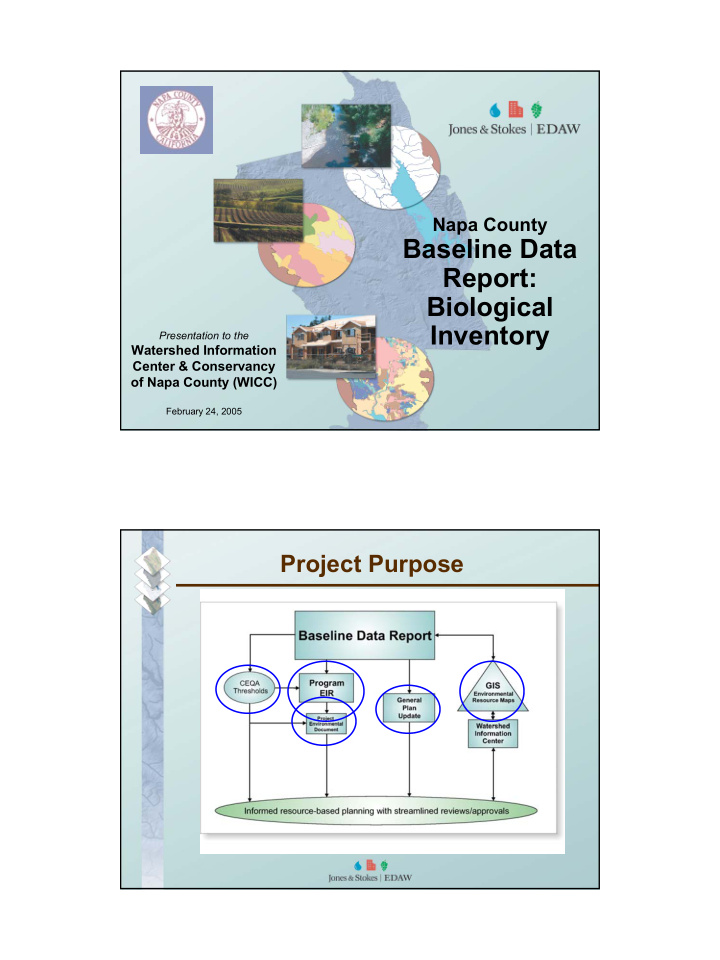



Napa County Baseline Data Report: Biological Inventory Presentation to the Watershed Information Center & Conservancy of Napa County (WICC) February 24, 2005 Project Purpose Project Purpose
Biological Resources Inventory Biological Resources Inventory Purposes � Document current conditions in County � Provide tool for site and regional planning � Basis to evaluate and develop policy � Provide tool to community Components of Inventory Components of Inventory � Biological Resources Report � Biological Resources Database
Inventory Content Inventory Content � UC Davis ICE Land Cover Map � Unique regional data set � 59 land cover types, almost 30,000 polygons � 2.5 acre MMU, based on 1993 air photos � 7 broad biological communities � key ecological processes � management issues � 13 Evaluation Areas � sensitive biological resources � management issues Inventory Content Inventory Content � Other elements � regulatory setting � special status species � wildlife movement � care and feeding of biological database
Selected Findings Selected Findings � 81 plant species (more species are on a watchlist) � 85% have less then 10 known occurrences � 2 plants only found in Napa County � 60 wildlife species � 2/3 of the special status wildlife species are birds � 9 fish species � 29 sensitive communities � Every natural community has associated special status species
Selected Findings Selected Findings � Some communities are especially critical to special status species � Serpentine grasslands: � Associated with 36% of the County’s special status plant species � Mapped on 0.4% of the County’s area Species-Community Associations Species-Community Associations Community % of SS % of SS % of Plants Wildlife County Area Salt Marsh 5% 26% 0.7% Coniferous 47% 33% 8.5% Grassland 47% 31% 10.6% Serpentine 36% 31% 0.4% Grassland Riparian 11% 38% 1.6% Woodland Serpentine 25% 16% 9.2% Chaparral
Case Study 1: Western Mountains Case Study 1: Western Mountains � 40% oak woodlands- SOD is an issue � Valuable riparian habitats � 25% Doug-fir/Redwoods � Fire regime/fuel management is an issue � Most occurrences of Northern spotted owl � Potential GP EIR issue: constrained north-south wildlife movement Source:http://kellylab.berkeley.edu/OakMapper/
Case Study 2: Knoxville Case Study 2: Knoxville � Dominated by chaparral � serpentine chaparral (30%) � other chaparral (22%) � 40% of County’s serpentine grassland � Oak woodlands- 30% � Putah and Eticuera Creeks � Sensitive communities- McNab cypress, Brewer willow � Special-status species “hotspot”
Wildlife Movement Wildlife Movement � Modeled movement “cost” by land cover type � Range 1 to 10 � Can evaluate regional effects on movement from different development scenarios Wildlife Movement Wildlife Movement � Least Cost Path Analysis � Evaluate movement for wildlife sensitive to human disturbance � Can combine with barriers or hazards (e.g., roads) � Can overlay different development or zoning scenarios
Biological Database Content Biological Database Content � GIS Maps � Vegetation types � Special Status Species Occurrences � Wildlife movement predictions � Vernal pool layer � Special Status Species Characteristics � Habitat preferences and distribution � Regulatory status � Plant blooming time- scheduling surveys � Linkage between GIS maps and Species Characteristics
Database Uses Database Uses � Initial Site Planning � Biological Constraints • Species, habitats, communities • Facilitates avoidance and minimization of impacts � Survey needs- which species at what season � Impact Analysis � Mitigation Planning � Provides focus for required site surveys Database Uses Database Uses � Regional Planning � Conservation & Open Space Planning � Transportation/Infrastructure planning � General Plan Updates � Specific Plans � Program EIRs � Policy development and analysis � Fuels Management
Database Users Database Users � City and County Planners � Project Applicants’ Consultants � Land Trusts and Other Conservation Organizations � State/Federal/Local Agencies � Landowners � Universities � Community members DEMO DEMO
Database Maintenance Database Maintenance � Database is only as good as the data contained in it � Updates Needed � CNDDB (every 6 months) � Ag/Development (every 2 years) � Recovery after wildfires (as needed) � Vernal pool data (every 5 years) � New unique datasets (as available) � Special status species regulatory status � Refinement of species distributions with new data Conclusions Conclusions � Biological Resources Inventory has wide application � Initial site planning � Regional planning � Public information � Database interface can be made user-friendly � Database must be updated to remain useful
Recommend
More recommend